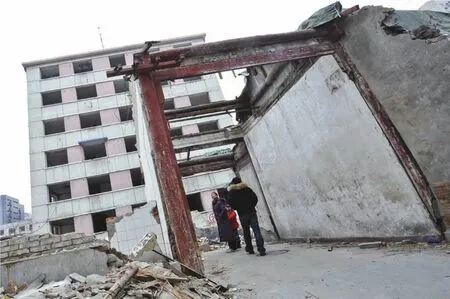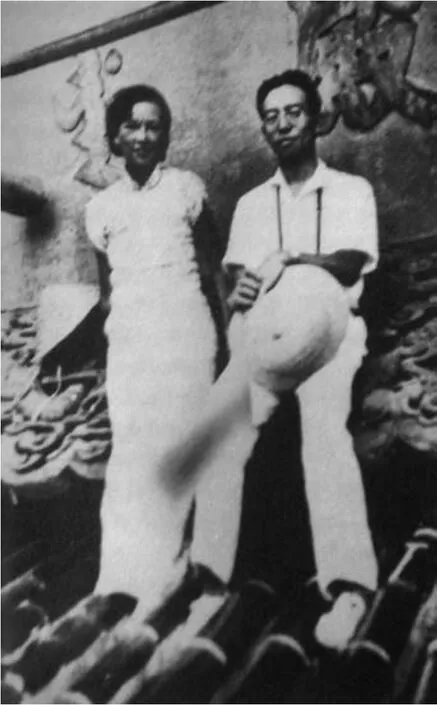Losing the Past
2012-10-14DemolitionofhistorichomecausespublicoutcryByYuYan
Demolition of historic home causes public outcry By Yu Yan
Losing the Past
Demolition of historic home causes public outcry By Yu Yan

IN RUINS: The ruined gateway of the former Beijing residence of Liang Sicheng and Lin Huiyin, famous Chinese architects
Should historic cultural buildings huddle at the corner of cities as stumbling blocks of urbanization, or shine as precious cultural resources providing power for city development? This question was once again put to the public following the recent demolition of a quadrangle courtyard in Beizongbu Hutong, Dongcheng District of Beijing, former residence of famous Chinese architects Liang Sicheng (1901-72) and Lin Huiyin (1904-55).
From 1931 to 1937, the couple rented the courtyard and lived there, a peak time in their careers. Setting off from this courtyard,they completed their field investigations on ancient Chinese building groups, leaving footprints all over China. Based on these studies,they attained great achievements in Chinese architectural history and architectural relic protection, and were considered as founders of Chinese architectural history studies in China.
Lin was not only a famous architect, but also a beautiful woman who wrote excellent prose, poetry and dramas. The residence was once an extremely popular meeting place for the literary circle in the 1930s.
Because of the couple’s reputation, the courtyard, rebuilt in the 1980s, was listed as a newly discovered cultural relic in China’s third national cultural relic survey published in December, 2011. All items registered in this survey are protected by law, said the State Administration of Cultural Heritage.
But the real estate developer demolished the residence during the past Spring Festival holiday (January 22-28). When it was exposed, it drew a flood of attention and soon became a hot topic.
The issue
All of Beizongbu Hutong is no longer what it used to be. Several decades ago, it was a quiet and beautiful residential area consisting of traditional quadrangle courtyards. Now they have been replaced by modern multifl oor buildings. It serves as a sharp display of urbanization and modernization in Beijing.
The demolition in this area began in July,2009. Along with other courtyards in this area, the gateway and west-wing rooms of the architects’ residence were removed to make room for a real estate project including a hotel, an of fi ce building and apartments.
This aroused huge public response.Several days later, the Beijing Municipal Commission of Urban Planning halted the demolition when they found the former residence of Liang and Lin was in the area.
On July 28, 2009, the Beijing Municipal Administration of Cultural Heritage declared it had studied the protection issue of Liang and Lin’s former residence jointly with the Beijing Municipal Commission of Urban Planning. It had urged the construction company to change its plan, making sure the courtyard was preserved.
The courtyard had been listed as a cultural relic. After all the residents moved out,it would be restored and refurnished, said Li Chenggang, an official from Dongcheng District, on January 11, 2011.
But on January 27, 2012, it was exposed that the home had already been demolished.
The construction company claimed it demolished the home because the houses in the courtyard were too old and might cause danger during the Spring Festival holiday, according to Dongcheng District Cultural Commission’s report to the Beijing Municipal Administration of Cultural Heritage.
It was a reparatory demolition and sort of preparatory work before the repair, said the report.
On January 28, Dongcheng District Cultural Commission added the demolition was illegal as it was done without approval,and declared the issue would be dealt with according to the law.
Following that, it ordered the construction company not to continue to remove any existing historic buildings in the courtyard. It requested the company to properly preserve all the materials for repair use.
At present, the company has begun to clean up the site and plans to start the restoration soon.
Debates
However, this did not put out the anger of the cultural heritage preservation circle.The demolition challenged the bottom line of civilization and there should be no more such demolitions in the future, said Zeng Yizhi, a staunch advocate of the protection of urban historic buildings.
Zeng was once a senior journalist and editor forHeilongjiang Dailyin northeast China. Since she established City and People,a special issue of the newspaper aimed at protecting historic buildings in cities in 1998,she has been dedicated to the cause of cultural heritage protection.
As far as Zeng saw it, Liang and Lin’s former residence had already become a symbol of culture. Its removal gave her a feeling of collapse.
According to regulations on the administration of cultural heritage conservation projects, even if the buildings in the courtyard were in dangerously poor condition, they should be urgently consolidated by quali fi ed construction companies but not be removed,said Zeng.

THE COUPLE: Liang Sicheng and Lin Huiyin pose for a photo while researching China’s ancient architecture
The excuse of reparatory removal was not persuasive at all. There was no such term in any cultural heritage laws or regulations, said Zeng.
The party that had demolished the courtyard should be investigated for legal responsibility, said Zeng.
The current situation is that the “cost” of destroying non-moveable cultural relics is too low.The lawbreaker pays a maximum of 500,000 yuan ($79,350) fi ne. So far, no one has been sentenced for criminal responsibility for destroying non-movable cultural relics, said Zeng.
What’s more, Liang and Lin’s students were against the Dongcheng District Cultural Commission’s decision of rebuilding the former residence from the debris.
Based on international practice, cultural relics that had already been destroyed cannot be rebuilt. It was already wrong to demolish a cultural relic, and would be more wrong to rebuild a fake antique, said Chen Zhihua, an 83-year-old professor from Tsinghua University and also a former student of Liang and Lin.
Some students said the government could build a ruins park at the site. It is essential to erect a monument for the couple, and retain the ruin as a warning to future generations, they said.
If the government did want to build something, it could build a memorial based on the principle of being distinguishable. The memorial should be different from the original buildings in architectural forms so that people wouldn’t be confused, said Chen.
Lessons
The miserable ending of the former residence of Liang and Lin serves as a mirror. It re fl ects the reality that many historic and cultural buildings are being abandoned and destroyed in China’s ongoing urbanization process.
According to China’s third national cultural relic survey, by the end of 2011, there had been altogether 766,722 registered non-moveable cultural relics on the Chinese mainland.Of them, 536,001 are newly discovered and about 44,000 disappeared in the urbanization process. Beijing has 3,840 non-moveable cultural relics, of which 969 have disappeared.
Fortunately, the reality has already aroused the attention of the public.
“A city is formed little by little. The historic cultural buildings were witnesses of history. We couldn’t destroy them recklessly.Even if they had to be demolished, the demolition should be carried out according to legal procedures,” said Fang Zhenning, a famous architectural critic.
There were many small details about an ancient building which are worth careful study and appreciation, said Luo Zhewen,another student of Liang and an expert on ancient buildings.
Luo suggested while working on protection plans, the regulators should take into consideration the history of famous people’s former residences.
“Some people only see the immediate economic interests brought by the removal of the ancient buildings,” said Ruan Sanyi, a famous Chinese expert on ancient building protection.“They removed the ancient buildings only to establish several real estate projects. These were very short-sighted actions.”
Ruan said compared to capital shortage in ancient building protection, the lack of protection consciousness and the backwardness of protection concepts were more worrisome.
“Of course, to protect ancient buildings doesn’t mean they can’t be touched.Protection should be combined with development, enabling them to shine in modern society,” said Ruan.
